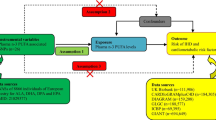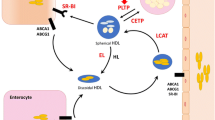Abstract
Both metabolomic and genomic approaches are valuable for risk analysis, however typical approaches evaluating differences in means do not model the changes well. Gene polymorphisms that alter function would appear as distinct populations, or metabotypes, from the predominant one, in which case risk is revealed as changed mixing proportions between control and case samples. Here we validate a model accounting for mixed populations using biomarkers of fatty acid metabolism derived from a case/control study of acute coronary syndrome subjects in which both metabolomic and genomic approaches have been used previously. We first used simulated data to show improved power and sensitivity in the approach compared to classic approaches. We then used the metabolic biomarkers to test for evidence of distinct metabotypes and different proportions among cases and controls. In simulation, our model outperformed all other approaches including Mann–Whitney, t tests, and χ 2. Using real data, we found distinct metabotypes of six of the seven activities tested, and different mixing proportions in five of the six activity biomarkers: D9D, ELOVL6, ELOVL5, FADS1, and Sprecher pathway chain shortening (SCS). High activity metabotypes of non-essential fatty acids and SCS decreased odds for acute coronary syndrome, however high activity metabotypes of 20-carbon fatty acid synthesis increased odds. Our study validates an approach that accounts for both metabolomic and genomic theory by demonstrating improved sensitivity and specificity, better performance in real world data, and more straightforward interpretability.



Similar content being viewed by others
References
Aslibekyan, S., et al. (2012). Genetic variation in fatty acid elongases is not associated with intermediate cardiovascular phenotypes or myocardial infarction. European Journal of Clinical Nutrition, 66, 353–359. doi:10.1038/ejcn.2012.2.
Assmann, G., Cullen, P., & Schulte, H. (2002). Simple scoring scheme for calculating the risk of acute coronary events based on the 10-year follow-up of the prospective cardiovascular Munster (PROCAM) study. Circulation, 105, 310–315.
Block, R. C., Harris, W. S., Reid, K. J., Sands, S. A., & Spertus, J. A. (2007). EPA and DHA in blood cell membranes from acute coronary syndrome patients and controls. Atherosclerosis, 197, 821–828.
Broadhurst, D., & Kell, D. B. (2006). Statistical strategies for avoiding false discoveries in metabolomics and related experiments. Metabolomics, 2, 171–196.
Chambless, L. E., et al. (2003). Coronary heart disease risk prediction in the Atherosclerosis Risk in Communities (ARIC) study. Journal of Clinical Epidemiology, 56, 880–890.
Cook, N. R. (2007). Use and misuse of the receiver operating characteristic curve in risk prediction. Circulation, 115, 928–935.
Cook, N. R. (2008). Statistical evaluation of prognostic versus diagnostic models: Beyond the ROC curve. Clinical Chemistry, 54, 17–23.
D’Agostino, R. B, Sr, et al. (2008). General cardiovascular risk profile for use in primary care: The Framingham heart study. Circulation, 117, 743–753.
De Backer, G., et al. (2004). European guidelines on cardiovascular disease prevention in clinical practice. Third Joint Task Force of European and other Societies on Cardiovascular Disease Prevention in Clinical Practice (constituted by representatives of eight societies and by invited experts). Atherosclerosis, 173, 381–391.
Dumas, M. E. (2012). Metabolome 2.0: Quantitative genetics and network biology of metabolic phenotypes. Molecular BioSystems, 8, 2494–2502. doi:10.1039/c2mb25167a.
Ferdinandusse, S., et al. (2001). Identification of the peroxisomal beta-oxidation enzymes involved in the biosynthesis of docosahexaenoic acid. Journal of Lipid Research, 42, 1987–1995.
Flowers, M. T., & Ntambi, J. M. (2008). Role of stearoyl-coenzyme A desaturase in regulating lipid metabolism. Current Opinion in Lipidology, 19, 248–256. doi:10.1097/MOL.0b013e3282f9b54d.
Folsom, A. R., et al. (2006). An assessment of incremental coronary risk prediction using C-reactive protein and other novel risk markers: The atherosclerosis risk in communities study. Archives of Internal Medicine, 166, 1368–1373.
Fraley, C., Raferty, A. E., Murphy, T. B., & Scrucca, L. (2012). Mclust version 4 for R: Normal mixture modeling for model-based clustering, classification, and density estimation (4th ed.). Seattle, WA: Department of Statistics, University of Washington.
Green, C. D., & Olson, L. K. (2011). Modulation of palmitate-induced endoplasmic reticulum stress and apoptosis in pancreatic beta-cells by stearoyl-CoA desaturase and Elovl6. American Journal of Physiology-Endocrinology and Metabolism, 300, E640–E649. doi:10.1152/ajpendo.00544.2010.
Holmes, E., Wilson, I. D., & Nicholson, J. K. (2008). Metabolic phenotyping in health and disease. Cell, 134, 714–717. doi:10.1016/j.cell.2008.08.026.
Jeyakumar, S. M., Lopamudra, P., Padmini, S., Balakrishna, N., Giridharan, N. V., & Vajreswari, A. (2009). Fatty acid desaturation index correlates with body mass and adiposity indices of obesity in Wistar NIN obese mutant rat strains WNIN/Ob and WNIN/GR-Ob. Nutrition and Metabolism, 6, 27. doi:10.1186/1743-7075-6-27.
Kim, W., Gordon, D., Sebat, J., Ye, K. Q., & Finch, S. J. (2008). Computing power and sample size for case-control association studies with copy number polymorphism: Application of mixture-based likelihood ratio test. PLoS ONE, 3, e3475. doi:10.1371/journal.pone.0003475.
Liu, K., Luedtke, A., & Tintle, N. (2013a). Optimal methods for using posterior probabilities in association testing. Human Heredity, 75, 2–11. doi:10.1159/000349974.
Liu, Y., et al. (2013b). Genetic analysis of the ELOVL6 gene polymorphism associated with type 2 diabetes mellitus. Brazilian Journal of Medical and Biological Research, 46, 623–628. doi:10.1590/1414-431X20133103.
Lloyd-Jones, D. M., Liu, K., Tian, L., & Greenland, P. (2006). Narrative review: Assessment of C-Reactive protein in risk prediction for cardiovascular disease. Annals of internal medicine, 145, 35–42.
Lu, Y., et al. (2012). Markers of endogenous desaturase activity and risk of coronary heart disease in the CAREMA cohort study. PLoS ONE, 7, e41681. doi:10.1371/journal.pone.0041681.
Matsuzaka, T., et al. (2012). Elovl6 promotes nonalcoholic steatohepatitis. Hepatology, 56, 2199–2208. doi:10.1002/hep.25932.
Mendell, N. R., Finch, S. J., & Thode, H. C, Jr. (1993). Where is the likelihood ratio test powerful for detecting two component normal mixtures? Biometrics, 49, 907–915.
Morcillo, S., et al. (2011). ELOVL6 genetic variation is related to insulin sensitivity: A new candidate gene in energy metabolism. PLoS ONE, 6, e21198. doi:10.1371/journal.pone.0021198.
Morgan, T. M., Krumholz, H. M., Lifton, R. P., & Spertus, J. A. (2007). Nonvalidation of reported genetic risk factors for acute coronary syndrome in a large-scale replication study. The Journal of the American Medical Association 297, 1551–1561. doi:10.1001/jama.297.14.1551.
Raftery, A. E. (1995). Bayesian model selection in social research. Sociological Methodology, 25, 111–163. doi:10.2307/271063.
Rhee, S. K., Kayani, A. J., Ciszek, A., & Brenna, J. T. (1997). Desaturation and interconversion of dietary stearic and palmitic acids in human plasma and lipoproteins. American Journal of Clinical Nutrition, 65, 451–458.
Ridker, P. M., Buring, J. E., Rifai, N., & Cook, N. R. (2007). Development and validation of improved algorithms for the assessment of global cardiovascular risk in women: the reynolds risk score. The Journal of the American Medical Association, 297, 611–619.
Ridker, P. M., Paynter, N. P., Rifai, N., Gaziano, J. M., & Cook, N. R. (2008). C-Reactive protein and parental history improve global cardiovascular risk prediction. The Reynolds Risk Score for Men. Circulation, 118, 2243–2251.
Shearer, G. C., Pottala, J. V., Spertus, J. A., & Harris, W. S. (2009). Red blood cell fatty acid patterns and acute coronary syndrome. PLoS ONE, 4, e5444. doi:10.1371/journal.pone.0005444.
Shin, S. Y., et al. (2014). An atlas of genetic influences on human blood metabolites. Nature Genetics, 46, 543–550. doi:10.1038/ng.2982.
Sprecher, H. (2000). Metabolism of highly unsaturated n-3 and n-6 fatty acids. Biochimica et Biophysica Acta, 1486, 219–231.
Tintle, N. L., et al. (2014). A genome-wide association study of saturated, mono- and poly-unsaturated red blood cell fatty acids in the Framingham Heart Offspring Study. Prostaglandins Leukotrienes and Essential Fatty Acids,. doi:10.1016/j.plefa.2014.11.007.
Vasan, R. S. (2006). Biomarkers of cardiovascular disease: molecular basis and practical considerations. Circulation, 113, 2335–2362.
Vessby, B., Gustafsson, I. B., Tengblad, S., Boberg, M., & Andersson, A. (2002). Desaturation and elongation of fatty acids and insulin action. Annals of the New York Academy of Sciences, 967, 183–195.
Wang, L., Folsom, A. R., & Eckfeldt, J. H. (2003). Plasma fatty acid composition and incidence of coronary heart disease in middle aged adults: The Atherosclerosis Risk in Communities (ARIC) Study. Nutrition, Metabolism and Cardiovascular Diseases, 13, 256–266.
Warensjo, E., Sundstrom, J., Vessby, B., Cederholm, T., & Riserus, U. (2008). Markers of dietary fat quality and fatty acid desaturation as predictors of total and cardiovascular mortality: A population-based prospective study. American Journal of Clinical Nutrition, 88, 203–209.
Westerhuis, J. A., et al. (2008). Assessment of PLSDA cross validation. Metabolomics, 4, 81–89.
Wilson, P. W., D’Agostino, R. B., Levy, D., Belanger, A. M., Silbershatz, H., & Kannel, W. B. (1998). Prediction of coronary heart disease using risk factor categories. Circulation, 97, 1837–1847.
Xia, J., Broadhurst, D. I., Wilson, M., & Wishart, D. S. (2013). Translational biomarker discovery in clinical metabolomics: an introductory tutorial. Metabolomics, 9, 280–299. doi:10.1007/s11306-012-0482-9.
Acknowledgments
The authors acknowledge John Spertus and William Harris for their work on the parent Project and in generating the data. Additional support was provided by the USDA Intramural Project 5306-51530-019-00D and the NIH, project 1U24DK097154-01 and R15HG006915. The USDA is an equal opportunity provider and employer.
Conflict of interest
Nathan L. Tintle and John W. Newman declare they have no conflicts. Gregory C. Shearer has received investigator-initiated research grants from the California Walnut Commission. Gregory C. Shearer has received speakership honorarium from Frerrer Gruppo.
Ethical approval
All procedures performed in studies involving human participants were in accordance with the ethical standards of the institutional and/or national research committee and with the 1964 Helsinki declaration and its later amendments or comparable ethical standards.
Author information
Authors and Affiliations
Corresponding author
Electronic supplementary material
Below is the link to the electronic supplementary material.
Rights and permissions
About this article
Cite this article
Tintle, N.L., Newman, J.W. & Shearer, G.C. A novel approach to identify optimal metabotypes of elongase and desaturase activities in prevention of acute coronary syndrome. Metabolomics 11, 1327–1337 (2015). https://doi.org/10.1007/s11306-015-0787-6
Received:
Accepted:
Published:
Issue Date:
DOI: https://doi.org/10.1007/s11306-015-0787-6




